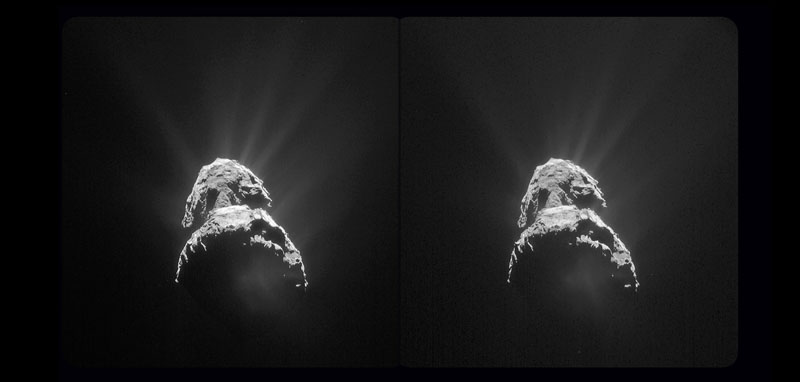New stereoscopic portrait of Comet 67P/Churyumov–Gerasimenko from images captured by Rosetta’s ‘Navcam’ camera.

For parallel free-viewing or use a stereoscope such as a London Stereoscopic Company OWL viewer. For information on stereo viewing please click here
Photo Details:
Left image: taken April 28, 2015, 05:27:04, at a distance of 150.9 km from the comet’s centre.
Right image: taken April 27, 2015, 16:56:15, at a distance of 134.2 km from the comet’s centre.
Released: Friday 23 October 2015
Source: Rosetta NAVCAM Archive Image Browser operated by the European Space Agency (ESA)
The component images for this stereo pair are to be found in the Rosetta NAVCAM archive image browser, where the Rosetta team release all these images to the public around six months after they are taken. The browser contains thousands of great images to explore.
In this picture we are looking at the 67P Comet three and a half months before perihelion, its closest approach to the Sun, so its activity was not yet at maximum.
We see the large ‘lobe’ of the comet (with the Imhotep region in darkness) looming in the foreground, and the smaller lobe well-lit behind it. In processing, we have done some compression of intensities to enhance the faint jets which are here seen forming the comet’s coma, while keeping the highlight detail on the nucleus intact. The 3-D image positively locates the jet activity, even right in the foreground, evidently emanating from the dark part of the large lobe which faces us.
We particularly liked this stereo, and gave it the ‘full polish treatment’. In addition to fine tuning the alignment and optimising levels, the shadows needed to be fixed. In the twelve and a half hours between exposures, which has given us a perfect baseline for great stereo detail, Comet 67P has rotated enough with respect to the Sun for the shadows to have significantly moved. If these discrepancies are left in the stereo image, our eyes are troubled by ‘retinal rivalry’ – ie conflict of information getting to the brain from our two eyes. The only way to sort this out is by individually copying the shadow shapes from the left image to the right, or vice versa, by hand. Each ‘patch’ has to be morphed to match the surface it’s being attached to, so the 3-D shape of the terrain is not disturbed, to keep the final image as ‘real’ as possible.
In twelve and a half hours, the jets have not perceptibly changed, and their three-dimensional structure in space seen here is completely real. It’s a rare chance to get an informative glimpse of the 3-D structure of a coma at short range, showing the way jets apparently orientate themselves perpendicular to the surface of the nucleus they emerge from, and stream out for some way in straight lines.
Credits: ESA/Rosetta/NAVCAM, CC BY-SA IGO 3.0
Stereo created by Claudia Manzoni and Brian May using these images in the Rosetta archive image browser :
– http://imagearchives.esac.esa.int/picture.php?/29025/category/119
– http://imagearchives.esac.esa.int/picture.php?/29030/category/119
Big thanks to Rosetta mission boss Matt Taylor for his help and approval, and to Joel Parker for his continued help in locating suitable image pairs.
Bri
PLEASE OBSERVE COPYRIGHT
© brianmay.com